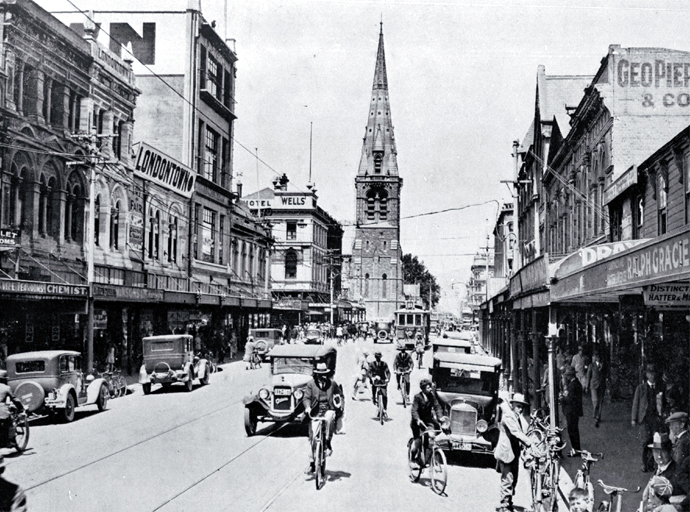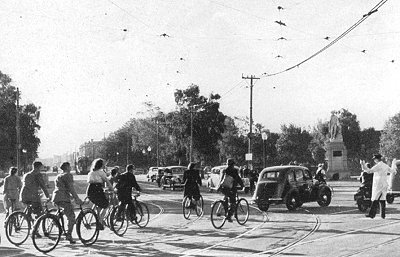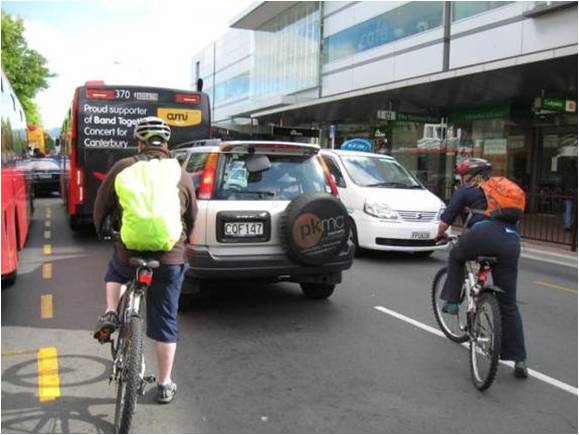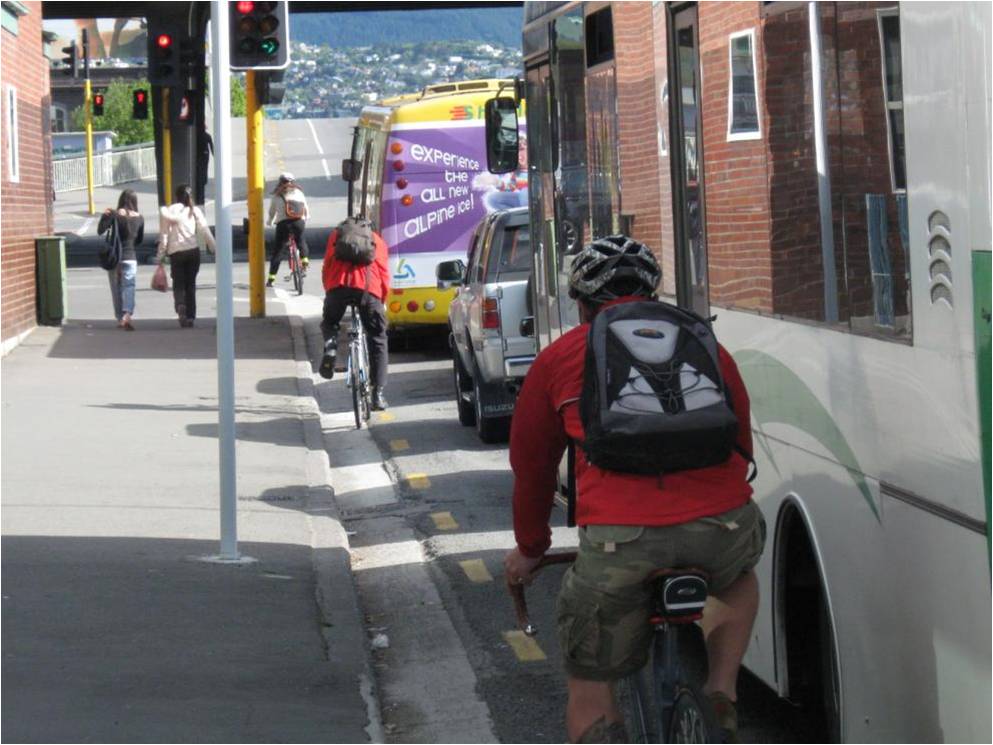Here’s an interesting thinkpiece from occasional guest blogger Robert:
How has it come to this?
The recent publicity about cycle safety, highlighting cycle-related deaths and injuries is a double-edged sword. On the one hand, emphasising the problems that cyclists have on the roads could have the effect of moderating some vehicle behaviour when around a cyclist. There is no sweeter sound when on a bike to hear the whirr of a slowing engine coming up behind you at an intersection. But when a faster revving engine is to be heard coming closer, a degree of fear sets in until the vehicle has passed successfully.
On the other hand (via the media) cyclists are now the target of scorn, mostly by a minority of motorists who believe us all to be law-breakers and deserve the consequences of our actions, and from an even smaller minority who believe that there is no place on New Zealand roads for any cyclist. Perversely, this thinking actually supports the case for separated cycle infrastructure. This may create the expectation that once such infrastructure has been built, then motorists will never have to contend with a sensible law-abiding cyclist nor a two-wheeled dare-devil ever again.
Wishful thinking maybe, but how is it going to happen?
But first, the facts about cycle safety in NZ. If you haven’t read what the experts say then do so and form your own opinion. Of course, perceptions and statistics aren’t always the best of bed buddies.

There are a multitude of reasons we are in this space right now. The journey starts in the very early part of last century as the automobile first made its presence on Christchurch streets. Thus the start of an era of transportation changes that has had a major impact on the lives of people, our economy and the standard of living. Growing along with the numbers of cars on the roads over the decades is the expectation that getting from one point to another anywhere in the city can be faster, easier, and more comfortable each year after the next. Our car can determine our status in life, it can portray our personality and above all it allows freedom of choice to go where and when we like. All of this has happened at the expense of outmoded and more inconvenient methods like walking, biking, the tram and more recently, the bus.

Road design during the post-war suburban development was to benefit car journeys as the number one priority. Initially for pleasure, but soon to be for getting to and from work and other day to day tasks. As more women developed careers, a second family car was added, firstly a bit of a luxury, then a necessity. As the ‘one job for life’ era gradually came to a close, living near your work became less commonplace. We changed houses more frequently to suit our life-style. Work was no longer just a short bike-trip away as it once was during a 40 year working life in the same job whilst living in the same house. So as the car traffic increased year on year the roads were built and modified (extra lanes, one way streets) to cater. As local shops once providing the staples on every corner developed into a few large supermarkets in malls strategically placed around the city with superior road access, even acquiring the basic provisions now requires a car-journey. Then came the mobile teenagers.
So we have come to the point of ‘more people, driving more cars, more often‘.
Result = more congestion, more frustration and unending development costs. Is this what the dream and reality of car ownership for all, actually promised?

When the Auckland Mayor, Sir Dove-Myer Robinson in 1966 suggested that Auckland needed to plan for a comprehensive rail network to prevent future traffic congestion, little did he know how many people would later wish that his foresight had been taken more seriously. If Christchurch transport planners had only been as cycle aware back then as they were car-centric … sigh.
But back to today and the safety issue. As I see it, there are two reasons why car drivers in some instances drive the roads as though cyclists don’t exist. One is that over the last few decades there have been a declining number of school students who no longer cycle to school. So there is a generation developing of drivers who possibly have never ridden at all. There is nothing like being or having been a cyclist to heighten one’s awareness of cycles on the road when driving. Secondly, recreational cycling in its several forms has boomed in the last couple of decades (in New Zealand since the 1970’s it is estimated that the number of cycles has increased by about 6 times and the number of people who say that they ride a bike increased by 7 times) but the actual number of everyday cyclists has not increased as much (everyday = commuters, school students, short journeys locally made). In fact, after a small increase during the 1980’s and 1990’s this number has recently declined. So fewer cycles on our roads has reduced the opportunity for good driving behaviour around cyclists. It could be suggested that part of the angst at present in Christchurch is because cyclist numbers have increased recently, and along with all the other motoring hazards and frustrations we have, adding more cyclists to be careful of, is just not fair.

Are there any answers to all of this?
Note that I have been careful to call it a cycle-safety debate. A debate that needs to be had, and a debate that will continue long after I have hung up my hi-viz jacket. Our proposed new cycle-ways are exciting. They will not eliminate the need for safer cycle-car interaction, so extra work will need to be done on other existing roading infrastructure to improve safety. Education is needed, we are indeed lucky to have the CCC Cycle Safe Programme in schools.
I can vouch for this, in our area it happens outside our house. Equally important is the change in culture required, where cycling is taken seriously as an active transport option and given equal importance with cars and pedestrians for the creation of a more liveable city. I look enviously to northern and western Europe where their cycle culture is taken for granted. How do they do it? Decades of good planning and a lot of money. We have SPOKES and other interested biking groups setting an example for developing a cycle culture and advocating at every level. And we have infrastructure progress (Ilam Road, well done everyone). So the news is encouraging.
“More people on more bikes, more often”

To finish, a quick story on the rather sad perception we have of cycling and safety. Earlier this year I spent a few days in hospital getting put back together after being knocked from my bike. Expectedly, when questioned by people of authority and medicine, the first topic covered was that of helmet wearing (yes, I had my helmet on) and hi-viz? (no, it was in my saddle-bag, such a hot day I naively thought a brightly coloured work shirt would suffice) but it was one comment from one medical staff member that really intrigued me.
“I would never cycle in Christchurch, it is much too dangerous”.
Being a tad sensitive at the time I took that to mean I was somehow responsible for the pain and discomfort I was feeling.
Does the same statement, I wonder, get conveyed to victims of car accidents?
Have a safe and enjoyable cycling experience everyone, things are going to improve.
